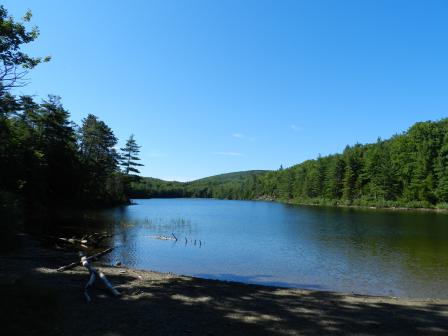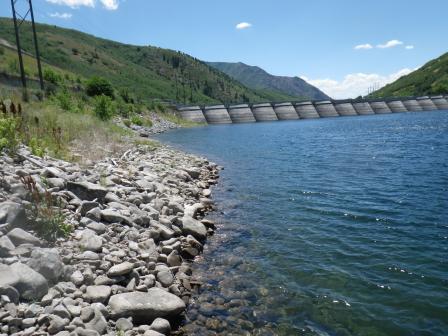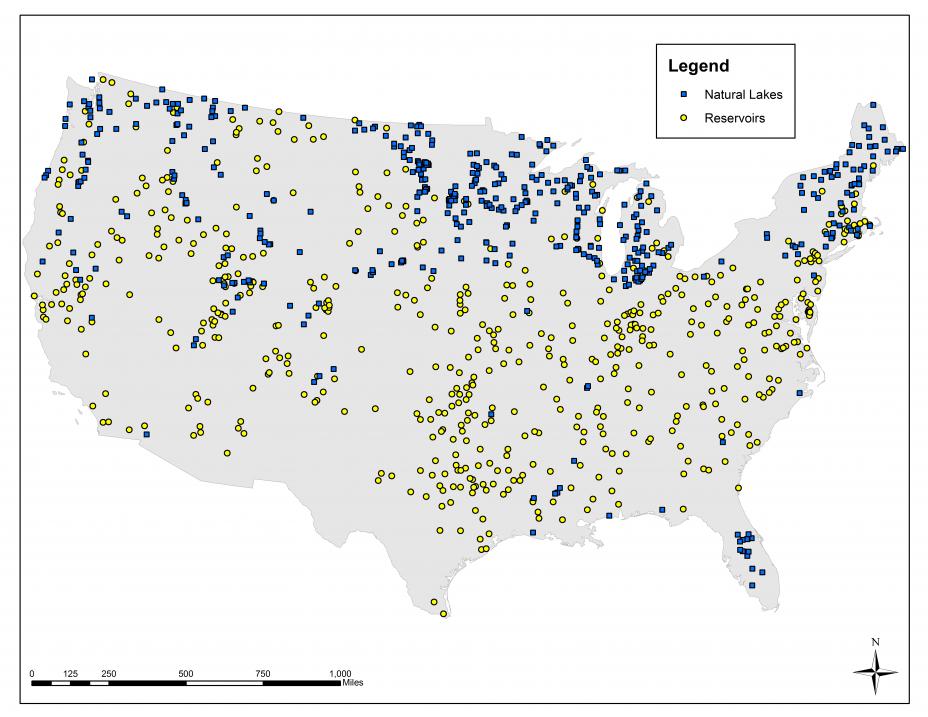National Highlight - Comparing Natural Lakes and Manmade Reservoirs
The statistical survey design includes both natural lakes and manmade reservoirs. The national and ecoregional results include data from both of these groups together. This highlight separates the data from lakes and reservoirs and explores the similarities and differences between these subpopulations.
Background
 Example of a natural lake - Lake Wood, Maine. Photo: Hilary Snook, EPA Region 1.For the National Lakes Assessment (NLA), analysts reviewed satellite imagery, visual assessments performed by field crews, and other available records to determine the origin of each sampled lake. Analysts defined natural lakes as those without evidence of a dam or where available information indicated the lake was natural even if a dam exists to augment the depth of the lake. Analysts defined manmade reservoirs as waterbodies that were constructed. Reservoirs are typically created to serve specific municipal or water resource management needs, such as drinking water supply, agricultural irrigation, industrial cooling for a water supply, flood control, fisheries, recreation, or navigation. They are often created by damming rivers or streams and flooding the surrounding floodplain. As such, some manmade reservoirs may have properties that reflect both lakes and flowing systems.
Example of a natural lake - Lake Wood, Maine. Photo: Hilary Snook, EPA Region 1.For the National Lakes Assessment (NLA), analysts reviewed satellite imagery, visual assessments performed by field crews, and other available records to determine the origin of each sampled lake. Analysts defined natural lakes as those without evidence of a dam or where available information indicated the lake was natural even if a dam exists to augment the depth of the lake. Analysts defined manmade reservoirs as waterbodies that were constructed. Reservoirs are typically created to serve specific municipal or water resource management needs, such as drinking water supply, agricultural irrigation, industrial cooling for a water supply, flood control, fisheries, recreation, or navigation. They are often created by damming rivers or streams and flooding the surrounding floodplain. As such, some manmade reservoirs may have properties that reflect both lakes and flowing systems.
 Example of a manmade reservoir - Mountain Dell Reservoir, Utah. Photo: Ben Brown, Utah Department of Environmental Quality.
Example of a manmade reservoir - Mountain Dell Reservoir, Utah. Photo: Ben Brown, Utah Department of Environmental Quality.Population
Based on the NLA 2012, of the total 111,119 lakes assessed, approximately 52% (58,700) were natural and 48% (53,119) were manmade. The NLA found that natural lakes are distributed fairly evenly in size from small to large while most manmade reservoirs are relatively small. For example, 40% of reservoirs are less than 10 acres (4 hectares) compared to 22% of lakes.
Distribution
Reservoirs occur throughout the United States, however, most natural lakes are concentrated in five ecoregions: the Upper Midwest, Northern Appalachians, Temperate Plains, Coastal Plains, and the Western Mountains. See the map below for the geographic distribution of natural lakes and manmade reservoirs sampled for the NLA in 2012.
 Distribution of NLA-sampled natural lakes (blue squares) and manmade reservoirs (yellow circles)
Distribution of NLA-sampled natural lakes (blue squares) and manmade reservoirs (yellow circles)
Key Differences
The NLA assessed both lakes and reservoirs using the same set of protocols and analytical procedures. While one might expect to see differences in the condition of these systems given their difference in origin, the NLA identified only six indicators that showed statistically significant differences at the national level – zooplankton, total phosphorus, lakeshore disturbance, chlorophyll a risk, total mercury in sediment, and methylmercury in sediment.
Assessment of four of these indicators (discussed below):
- zooplankton
- total phosphorus
- lakeshore disturbance, and
- chlorophyll a risk
showed that a higher percentage of reservoirs were in the most disturbed category compared to lakes.
Conversely, more lakes were in the most disturbed category compared to reservoirs for both total mercury and methylmercury levels (also discussed below).
Below are graphics that show the percentages of natural lakes and manmade reservoirs that were in the most disturbed condition category for each of these indicators. For information on the percentages of lakes and reservoirs that were in the least disturbed and moderately disturbed condition categories, see the Interactive NLA Dashboard. See the dashboard help guide for information on how to interpret the lake condition graphics.
Zooplankton

Total Phosphorus

Lakeshore Disturbance

Chlorophyll a Risk

Total Mercury

Methylmercury

